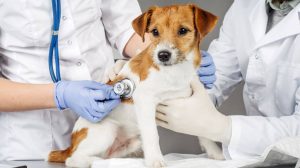Leptospirosis in dogs is a bacterial infection. Unfortunately, the symptoms of the disease are very vague. Since leptospirosis can be dangerous and transmitted to humans, you should prevent infection as much as possible. You can find out how this works and what you can do in the event of a condition here.

The insidious thing about leptospirosis is that there are almost 200 different types of leptospira, i.e. pathogens that can trigger it. This makes it difficult to develop a vaccine that protects against all these bacteria. Dogs in rural areas who like to swim outside in the water and animals with weakened immune systems are particularly at risk.
Leptospirosis in dogs: Symptoms are mostly non-specific
The symptoms of canine leptospirosis are similar to those of other infectious diseases, such as a common cold. However, they can vary from animal to animal. The severity of the individual complaints sometimes depends on the general state of health and the extent of the immune system. Adult, healthy dogs with high antibodies in their immune system and good vaccination protection usually survive an infection unscathed or only show mild symptoms. You also rarely have to fear long-term effects.
For example, leptospirosis in dogs can have the following symptoms:
● Weakness, exhaustion
● loss of appetite
● fever
● Muscle tremors
● vomiting
● diarrhoea
In severe cases, the bacteria attack the dog’s organs. Depending on which organs are affected, these serious symptoms can also occur:
● Liver: jaundice
● Gastrointestinal tract: bloody diarrhoea
● Kidneys: frequent urination, dehydration (dryness)
● Lungs: (bloody) cough, shortness of breath
In severe cases, the organ damage can be permanent, for example, in the form of kidney or liver insufficiency. In the worst case, an infection can even lead to the animal’s death. If the dog loses a lot of blood during leptospirosis, anaemia can also occur. This manifests itself, among other things, in pale mucous membranes.
Transmission of leptospirosis in dogs: causes and sources of danger
Dogs can be infected with leptospirosis both directly and indirectly. The direct transmission of the leptospira occurs, for example, via wild animals such as rats, mice and hedgehogs. In addition, sick dogs can infect their conspecifics during mating or through bite wounds. As soon as the animals come into contact with infected blood or urine, the risk of infection is very high.
The indirect transmission occurs because the bacteria can survive in moist environments for weeks. For example, if urine from infected wild animals gets into the ground, in puddles or brackish water, the leptospira patiently wait for a passing host. For instance, if your dog sniffs at such a spot, the pathogens can penetrate through the nasal mucous membranes. If he eats grass contaminated with infected urine, the bacteria enter his system through the mucous membranes in his mouth. Even the smallest injury to the paws can become a gateway for leptospira if your dog walks through a puddle while walking.
Diagnosis and treatment of leptospirosis in dogs
The diagnosis of leptospirosis in dogs is difficult due to the non-specific symptoms. A blood test can provide initial clues. The bacteria can be detected in the blood up to eight days after infection. In addition, the white blood cells are increased in the event of illness, but this also occurs with other infectious diseases. The suspicion of leptospirosis is substantiated if a so-called antibody test is positive.
If leptospirosis is suspected, your dog will be treated with so-called broad-spectrum antibiotics for three to four weeks. The treatment is divided into two phases with two different active ingredients. This is necessary because it is never possible to say which subspecies of leptospira your dog has contracted—a broad-spectrum antibiotic works against many other bacteria. The two phases are important so that the pathogens cannot develop resistance to an antibiotic so that the drugs no longer affect them. That would make the therapy of leptospirosis much more difficult.
How well does the vaccination against leptospirosis help?
Unlike the basic vaccination against distemper, hepatitis and parvovirus, the immunisation against leptospirosis has to be boosted once or twice a year. Also, the leptospirosis vaccine only protects against some of the subspecies of leptospira, meaning your dog can still contract the disease despite being vaccinated. However, the risk of infection with a valid vaccination is much lower than without vaccination.
For this reason, it is advisable to have dogs in rural areas, water-loving dogs, puppies, old animals and those with weakened immune systems vaccinated against leptospirosis in particular. Your veterinarian should use a vaccine as up-to-date as possible – the vaccine is constantly being developed to improve protection and be effective against more subspecies of the pathogen.
Preventing leptospirosis: what you can do
In addition to vaccination protection, you can protect your dog from leptospirosis by avoiding possible sources of danger as far as possible. Cleanliness and hygiene in your environment are already a good start. Since not all sources of risk can be avoided, the best way to help your dog is to strengthen its immune system: healthy, species-appropriate nutrition, generally adequate vaccination protection and dog-friendly activities. If your dog is getting old or is suffering from a chronic illness, ask your veterinarian which vitamin preparations and dietary supplements are suitable for your four-legged friend to support their immune system.
Caution! Leptospirosis is transmissible to humans.
Danger! Leptospirosis is a so-called zoonosis, a disease that can be transmitted from dogs to other animals and humans. Make sure that you contact your dog’s urine or saliva as little as possible. Should this happen anyway, wash your hands or face as soon as possible afterwards.









